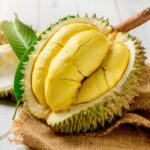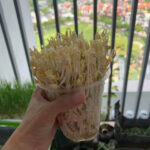Visual development in children under 6 years old also experiences significant leaps, reaching 0.6 at the age of 3, increasing to around 0.8 when they are 4-5 years old, and reaching approximately 1.0 when they are 6-8 years old, essentially attaining adult levels.
Since eye development goes hand in hand with height growth, a balanced diet to provide children with the necessary nutrition for both aspects is of utmost importance.
Experts suggest nutrient-rich foods that are essential for children’s visual and height development. Parents who include these foods in their children’s diets will “kill two birds with one stone.”

Calcium-rich foods: Milk, shrimp, seaweed…
Most of us associate calcium with height development. However, calcium plays a crucial role not only in bone building but also as an essential nutrient for eye health.
A calcium deficiency can lead to a decrease in the elasticity of the sclera (the white part of the eye), resulting in issues such as dry eyes, myopia, and other vision problems. Maintaining adequate calcium levels will enhance eye function and reduce the risk of eye diseases in the future.

Milk is an important source of calcium.
Calcium in milk has the highest absorption rate, so it is vital to ensure children consume 500ml of milk daily. In addition to milk, parents should include other calcium-rich foods such as egg yolks, shrimp, seaweed, black sesame seeds, soybeans, and leafy greens like kale, to enhance calcium, vitamin, and mineral intake necessary for children’s development.
However, calcium absorption needs to be balanced with other nutrients. Excessive phosphorus intake can inhibit calcium absorption, so parents should try to limit phosphorus-rich foods like instant noodles, cured ham, and other processed foods. This helps optimize calcium levels and protect the overall health of children.

Vitamin A-rich foods: Carrots, sweet potatoes, pumpkins…
Vitamin A can promote tear production, improve vision in low light, and enhance children’s color perception. Insufficient intake can lead to dry eyes, pain, and difficulty seeing in the dark.
In terms of height growth, vitamin A is involved in bone cell differentiation and stimulates the synthesis of growth hormones. Therefore, a lack of vitamin A will also impact height development.

Carrots are a prime example of a food rich in vitamin A.
If a child is significantly shorter than their peers, has short and thick bones, takes a long time to recover from illnesses, and has particularly dry skin, they may not be getting enough vitamin A. In this case, timely supplementation of this nutrient is necessary.
The absorption rate of vitamin A from animal sources is relatively high, so it is preferable to include animal liver in the diet, but the amount should be controlled, with an ideal intake of twice a week, approximately 50 grams each time.
Additionally, eat one egg daily and incorporate plant-based sources like carrots, sweet potatoes, pumpkins, red peppers, tomatoes, and red chilies. For better absorption, consume these with fish, meat, or eggs, or fry them.

Vitamin C-rich foods: Mainly fresh fruits like oranges, kiwis…
The eye lens is primarily composed of collagen and vitamin C. Collagen is also essential for maintaining the elasticity and transparency of the eyes. Vitamin C, a potent antioxidant, safeguards the eyes from the impact of free radicals and environmental factors, while also promoting collagen synthesis, keeping eyes healthy and bright.
Additionally, calcium, phosphorus, and magnesium are crucial for building and maintaining strong bones. These minerals are mainly deposited through vitamin D, which aids in robust bone development. Collagen is not only present in the eyes but also interwoven into the bone structure, making bones more resilient and robust. This is vital for children’s height development, as strong bones provide optimal support for bodily growth.

Vitamin C is mainly found in fresh fruits like oranges and kiwis.
Vitamin C plays an extremely important role in collagen production. A deficiency in vitamin C will impact collagen synthesis from protein, leading to the body’s inability to produce sufficient collagen. It can also slow down development, making children more susceptible to health issues and compromising their immune system.
To ensure children have bright eyes and ideal height, vitamin C supplementation is essential. Rich sources of vitamin C include fruits such as oranges, tangerines, kiwis, strawberries, bell peppers, broccoli, and kale.

Protein-rich foods: Eggs, meat, milk…
Protein is the primary component of all cells and is deeply involved in bone formation, regeneration, and renewal. Its importance is second only to calcium. Protein not only supports bone development but also plays a vital role in building and maintaining muscle tissue, skin, hair, and other body parts.
Additionally, rhodopsin in the retina is synthesized from protein, enabling the eye to perceive light and distinguish colors. This substance is crucial for the eye to adjust and adapt to varying light conditions, thereby improving night vision and color perception. This highlights the necessity of adequate daily protein intake for children’s eye health and brightness.

Children need adequate nutrition for optimal growth.
It is evident that children must consume sufficient protein daily for both height and eye health. Rich sources of protein include eggs, lean meats (such as pork, beef, and lamb), whole milk, yogurt, and beans.
Additionally, combining different foods in daily meals is essential. Children should be provided with a diverse range of foods from seven different color groups: red, yellow, green, purple, white, black, and brown.
The Ultimate Skin Care Quartet: 4 Essential Serums for a Youthful, Radiant Complexion
The secret to a glowing, youthful complexion lies in the proper use of serums. These potent elixirs are designed to penetrate deep into the skin, infusing it with a concentrated boost of active ingredients. By incorporating serums into your skincare routine, you’ll notice a visible transformation in your skin’s texture and appearance, revealing a radiant and smooth canvas that defies the signs of aging.
12 Ingenious Ways to Grow Bean Sprouts at Home Using Everyday Items
“Discover the secrets to growing delicious and plump bean sprouts at home with ease and speed. Uncover the simple methods using everyday kitchen items such as plastic baskets, bottles, milk cartons, and towels. Learn how to master the art of sprouting and enjoy the freshest ingredient in your meals.”







































